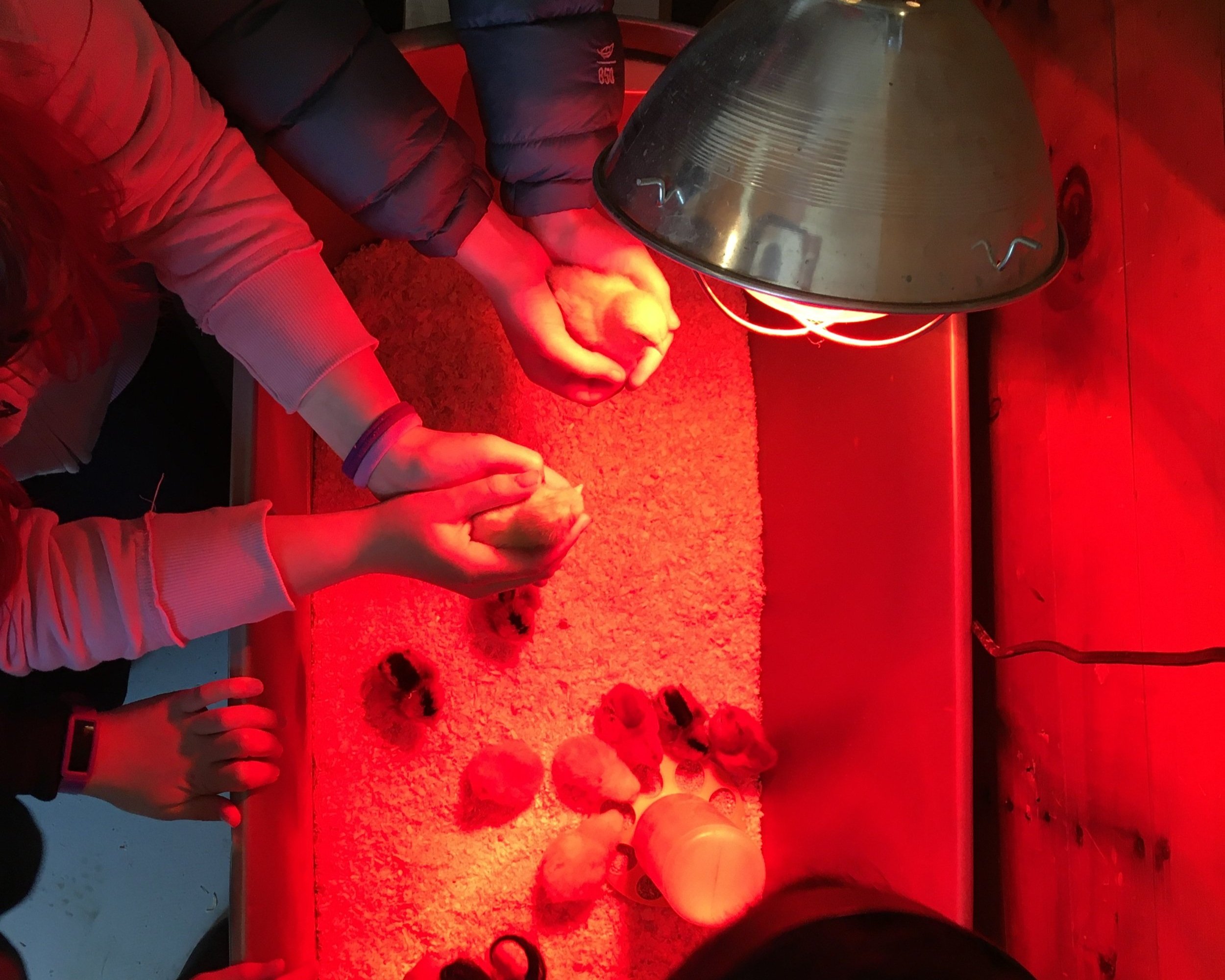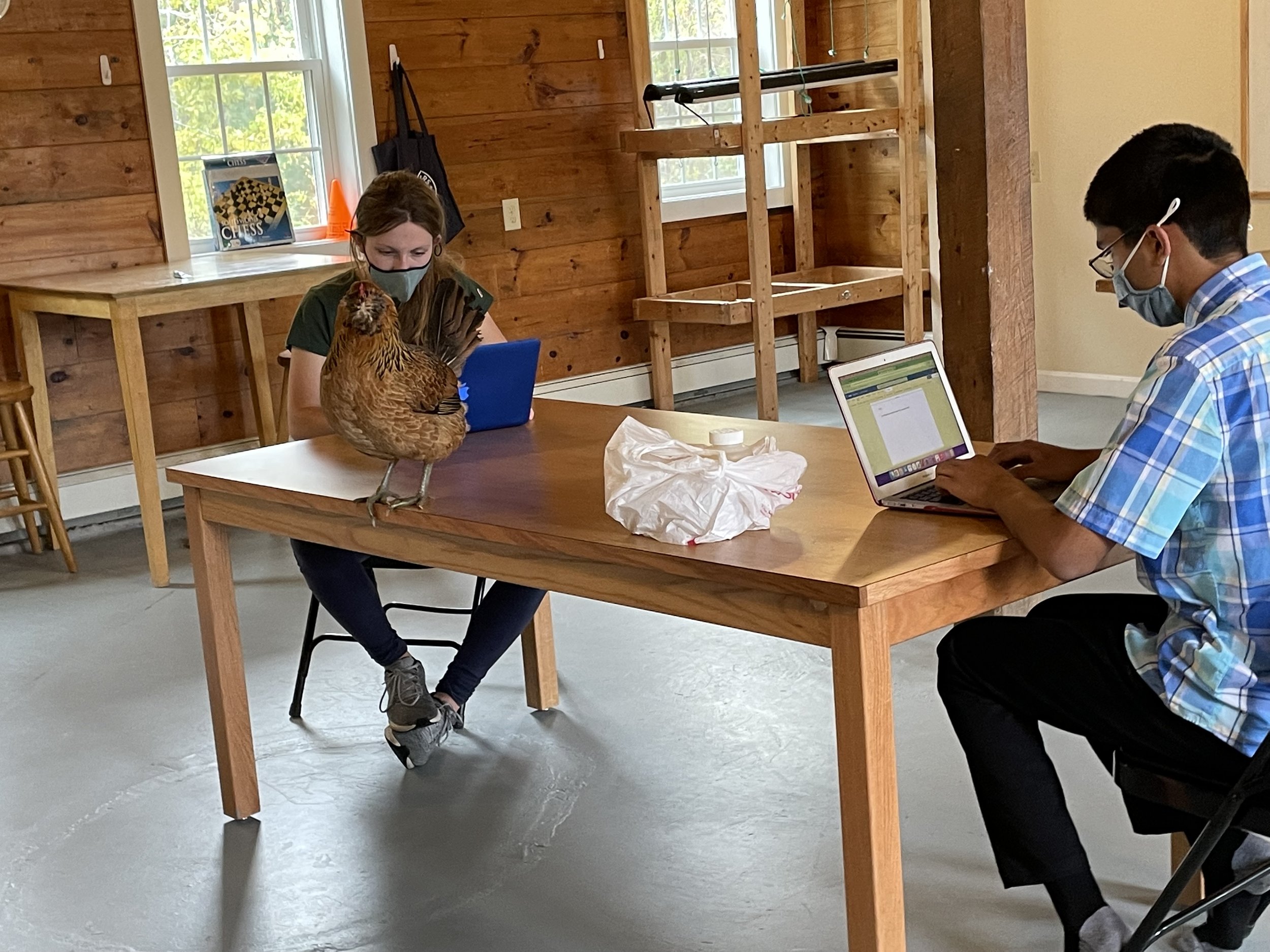Last October, as part of a larger unit on responsible land use, a group of students in our Adolescent Program (AP, grades 7-9) studied chickens—their anatomy, behavior, physiology, intelligence, needs, environmental impacts etc. It was the beginning of a journey that led to them starting to sell eggs this September as part of their class business, Sunny Orchard.
Adolescents long for work that is important and in which they have agency. A flock of chickens is within a scale that the students can really manage fairly independently. Having a flock of chickens is an excellent balance of a big challenge that stretches the students in many ways, but that is also something they can successfully manage. “Chickens are cute,” says AP 8th year student Emory Okano, “they make food, they're reasonably cheap to keep, and they're just all around awesome.”
According to AP 9th year student Anika Carlson, “It took a lot of preparation, and we really had to have everything prepared before we got the chicks, because there isn’t much you can change when you already have the chicks.” They researched different types of housing, ultimately deciding to go with a portable coop (a “chicken tractor”) with an open bottom so that the chickens can be easily moved about. This allows them to have access to fresh pasture, good bugs, vegetation, and dust baths, and their waste fertilizes the orchard. They also studied the nitrogen cycle to understand more about chicken waste and how to manage it.
“We first started with figuring out with what shelter we would have for the chicks,” says Anika, “and for when they became chickens.” The students created mock-ups of different designs of chicken tractors and then voted on the most practical one. They chose the A-frame design for its easy portability, appropriate size for 10 chickens, and because it has a way to protect the chickens at night from any potential predators. They priced out supplies, purchased them, and started building in March of 2021.
“The coop was fun to build,” says 8th year Zoe Ostermiller, “We got expertise on how to use some tools, and it was wonderful to think about how we were building it for chickens that we would care for.” “My main role was to put on the wheels of the chicken tractor and to staple the flooring of the coop,” says 9th year Pranai Rao, “all in all I learnt new things about how to build structures and how to make them more suitable for being outside.”
The process “really relied on problem solving, teamwork, and finding new ways to do things,” says 8th year Helen Saunders. They learned things like how to “cut metal, put on the top of the roof, and attach the bottom wire. We also are still fixing and redoing things when we encounter problems, like uneven roof overlap, lack of waterproofing, and wheel problems.” “I loved seeing the students develop skills involving measurement, problem solving, spatial reasoning, and using tools,” says AP Guide Susan Holmes Glazier. “It was so cool to see it go from pieces of lumber and metal to a home for animals - and cool to see the students proud of that work. We really appreciated the help of parents who pitched in as well.”
Around the same time, the baby chicks showed up. They stayed in a brooder inside the AP building for 8 weeks while they grew. When the chicks arrived “people were very excited,” says 9th year Naomi Carney, “we got to hold and observe them every day and we all agreed on what to name them.” As the chicks got older, the students took them outside for about an hour a day. “They were incredibly cute, pooped a lot, and slept a lot!” says Pranai. “However,” notes Anika, “we did have to remember to change their bedding, food, water etc. It was a new responsibility for everyone and I think we all had a lot of fun.”
As the chickens grew, lower school students came to visit and see what the fuss was about. “It was fun to teach the younger students what we knew,” says Anika. Susan Holmes Glazier notes, “I had an interesting conversation with a student in Lower Elementary about the role of roosters in a flock. He was convinced that roosters lay the eggs with the chicks inside them and the hens lay the eggs we eat.”
Children’s House II reading “Big Red Barn” to the chickens.
The students and guides divided up the work of caring for the chickens over the summer. “Every morning and every afternoon someone would come in to care for the chickens,” says Zoe. “It took a lot of responsibility to remember to take care of them, even when we wanted to sleep in,” adds Anika. Naomi says “my sisters really enjoyed coming in to hold them and play with them,” while Helen notes that “It was nice to have a way to stay connected with the school during the summer.” The process didn’t always go smoothly though. “For example,” says Pranai, “over the summer, I had to repair the coop a few times which would have been much easier if there were other people to guide me or suggest another solution.”
These days, the students have chicken chores every morning and afternoon, “filling water/food, gathering eggs, letting them out/putting them back in the coop,” says 8th year William Van Uitert. It’s “providing food, water, shelter, and heat,” says Emory, “the same as human care.” “We have discovered that chicken care usually necessitates at least two people,” notes Helen, “chasing the chickens when they get out is fun, but a bit frustrating at times.” The students also gather eggs to sell.
When asked what the best part of having chickens is, most of the students said holding them and playing with them was the most fun. Seventh year student Holly Gary likes to pick them up because “it is like having a portable dinosaur in your arms, but it's fluffier.” Zoe says she likes “caring for them and seeing all their individual personalities. The chickens are so curious!” Emory likes “putting them on people’s heads,” while Guide Susan Holmes Glazier notes “you can't take yourself too seriously with a chicken on your head.”
The students know that the chickens will die if they don't care for them well, so they step up their responsibility. While the students are very engaged in most of the work they do, there is nothing quite like having to take care of a living animal to bond people together, elicit compassion, and raise the level of responsibility. Having any animal requires ongoing study, work, and creativity. It is work that is never finished, and so keeps providing opportunities. As Helen Saunders notes, “the chickens have pretty much become members of the AP.”
This picture was taken the week this article was published.












